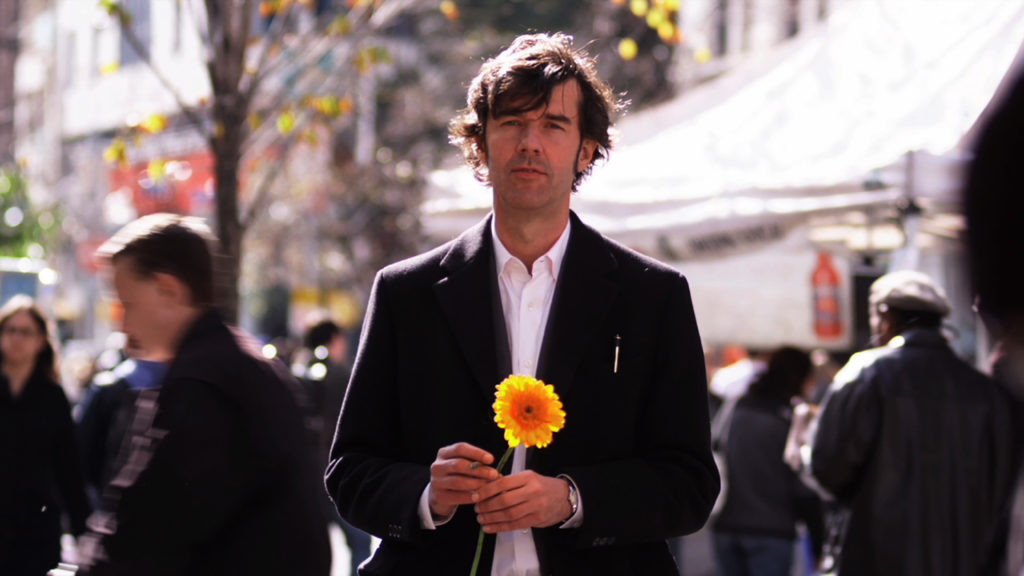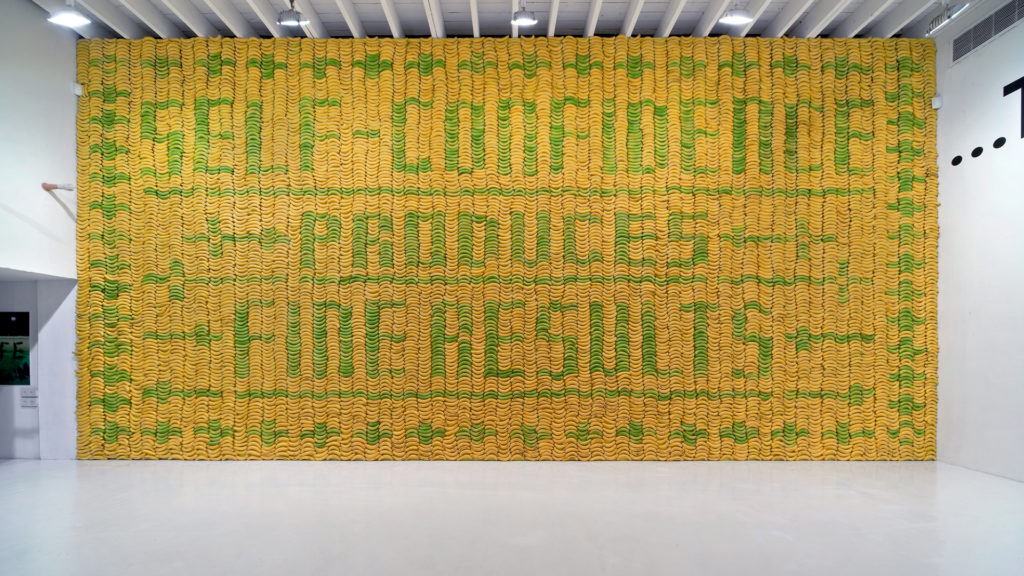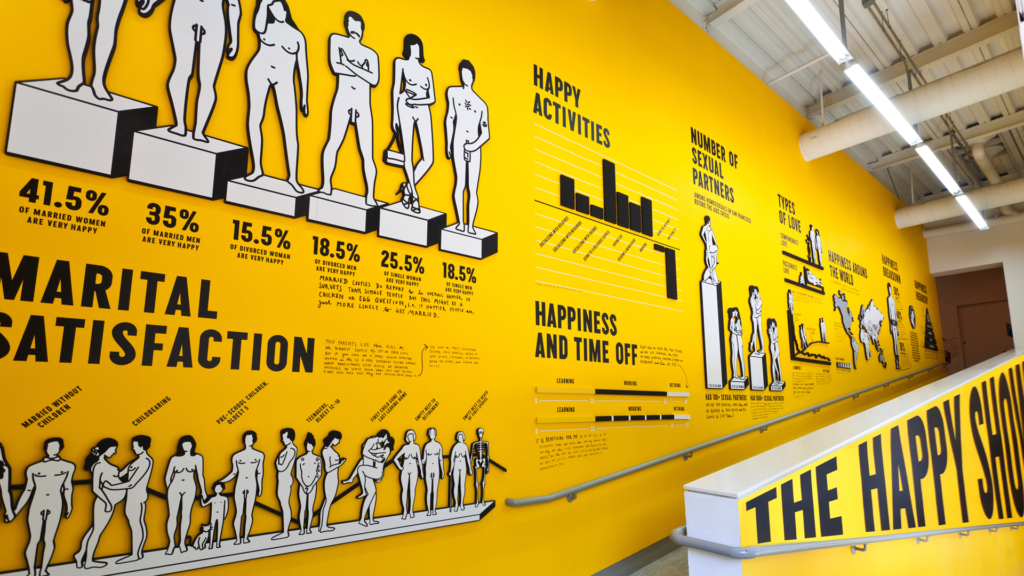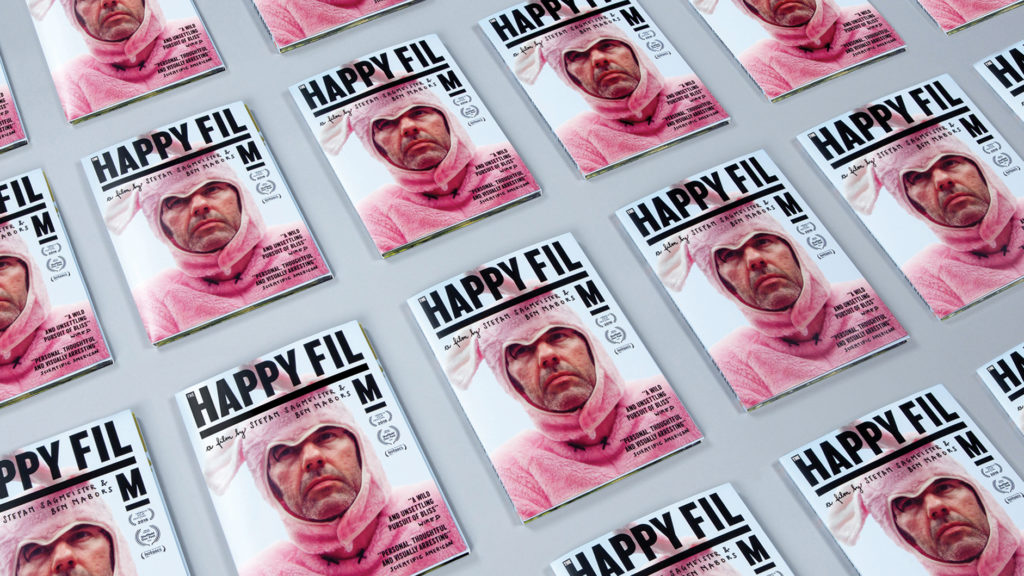
Stefan Sagmeister in ‘The Happy Film’, seeking discomfort on the streets of New York. Photograph: Ben Wolf.
The Happy Film
Duke of York’s Picturehouse
Preston Road, Brighton, East Sussex
14 June 2017 at 6pm
I’m not a fan of solo cinema visits but even with my partner-in-crime currently ‘away’, I had to see this just released, much discussed film at this special screening. Right on the money, the power-couple hosts of Glug Brighton, Carl Rush of creative agency Crush, and Helen, the renowned Illustration agent and founder of Agency Rush, invited graphic-design hero (and I don’t use the term lightly) Stefan Sagmeister to show his seven-years in the making documentary, The Happy Film. Despite the lure of a glorious summer evening, Brighton’s historic Duke of York’s cinema was packed with the city’s creative community including a good number of Graphic Design and Illustration students from University of Brighton, come to see the legend in action, for after a film of thrills and spills Sagmeister stepped up for the Q&A.
Subtitled ‘a graphic design experiment’, the film set out to show how a socially anxious, successful professional, middle-aged workaholic, serial dater who refers to women as girls, might achieve happiness by altering his personality through meditation, therapy or drugs. Sagmeister’s presence dominates the film: from his Werner-Herzog-styled voice-over (we later learn he took a class with the man himself); to the ubiquitous full-frontals, which I used to think were a casting-his-net-wide come-on but now recognise the metaphor as nowhere-to-hide honesty. During the course of shooting, Sagmeister became more central to the narrative than even he, the most extrovert of introverts, was comfortable with. For despite the carefully story-boarded script, and a trusted friend and respected film-maker on board as co-director, the film as exemplar of Sagmeister’s systemic thinking (diagnosed by the film’s medical expert) began to unravel. And as it did, the project’s aim of testing hypotheses culled from data and research generated by The Happy Show exhibition, was supplanted by Sagmeister’s ultra personal quest for happiness, which began to play out like the reality show from hell.
Initially, we see his logical approach to life and work; he lists pros-and-cons for the viability of relationships and tracks his behaviour with weekly charts. The film’s expert adds that systemic thinking is contradictory to feeling empathy. Ironically, it is the impending failure of the film project and the chaos it causes in Sagmeister’s life and work that are key to his growth. We see his relationships blossom and fail, and tragically, the co-director, Hillman Curtis, becomes ill and dies. Sagmeister experiences spiritual insights and the weight of drug-induced lethargy; the heights of ecstasy and the depths of despair, all of which blow his lists and logistics out the window. By the end of the film, after so much life lived, we have seen and heard Sagmeister, not only cut himself some slack, but also transform.
As an audience we enjoyed geeking-out on the hyper-inventive animated ‘memes’ that punctuate the live action. The double irony is that Sagmeister’s indomitably organised creative process produces such surreal, playful output that can also deliver a big message. Case in point is the DVD packaging showing a stubbly ‘grown man’ in a pink-fluffy-bunny onesie looking unsuitably upset. Celebrating chance and error, Sagmeister’s work is humorous, eccentric and entirely original: from his signature scratchy hand-written captions, quirky slot-machine interactives and saucy info graphics that make up the The Happy Show; to hand-crafted and multi-layered imagery made from flora and fauna, landscapes and the elements; to mucking in with the Japanese-game-show antics of his band of merry studio mates; plus those ubiquitous monkeys and bananas. And it looks as if yellow might make Sagmeister happy…

From the exhibition ‘Things I have learned in my life so far’, by Stefan Sagmeister, at Jeffrey Deitch, 76 Grand Street, New York. 31 January to 23 February 2008.

Saucy info graphics in ‘The Happy Show’, by Sagmeister & Walsh, Institute of Contemporary Art, University of Pennsylvania, Philadelphia. 4 April to 12 August 2012.
When it comes to the film though, ‘happy’ isn’t the full story. While not advocating for a change of title – it’s pure marketing genius – I’d suggest that Sagmeister’s film is about much more; from the creative process and the importance of relationships, to the need to improve our communication skills and not measure self-worth against unhealthy expectations. It also deals with the inevitability of death and the uncontrollable reality of grief. It may be happy, but it’s also heavy, as Sagmeister demonstrates that growth involves pain and balance is the most difficult thing to achieve. These issues are as real for members of the creative community in Brighton (at every stage of live and career), as for Sagmeister (however big his fan club). And that’s why I call him a hero; because he was in the privileged position of taking this opportunity to make such a film. It that could have been as empty as it is beautiful. Instead, he addressed serious issues, honestly and openly. Such striving for self-knowledge (he titled a previous book Things I have learned in my life so far) could be influential, aka, ‘best practice’ for all creatives.
At the end of the film, we see Sagmeister doing housework; he even admonishes himself for using the diminutive ‘girl’ when describing women. He sticks to the line that no, he isn’t happy, but he does acknowledge that discomfort helps us grow. For someone used to success, at times this project must have felt like failure and folly. Interviewed around the millennium (by me, read it, here), Sagmeister mentioned that every seven years he takes a sabbatical to make personal work, so by my count he’s about due for another. What to do next? Although he admits that documentary film-making is a very different discipline to graphic design, I’d watch another film made by this man, for at the end of The Happy Film it’s obvious that Sagmeister has become a wiser man. I hope that makes him happy.
It was great to see the vibrant creative community of my home town enjoying Sagmeister’s work, but such a message deserves to be heard beyond the design ghetto. Praised by the business magazine Forbes as a ‘feel good’ experience, why not bring The Happy Show to the UK? As the ‘most-visited graphic design exhibition ever’ its popularity is proof that a crossover audience exists for such thought-provoking entertainment. Supplement it with daily screenings of The Happy Film and the public would soon recognise the power of design to communicate more than just commercial messages.
If you can’t get to a screening of The Happy Film, you can buy and view it online, here. But I recommend watching this emotional roller-coaster of a film in public, for the positive collective experience it generates…and it looks great on the big screen.

